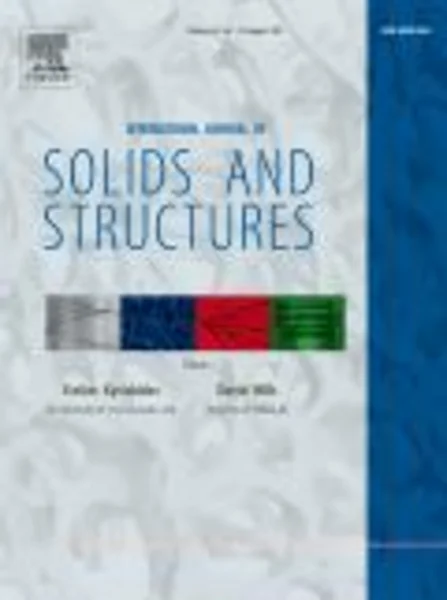-
temperature dependant polycrystal model application to bainitic steel behavior under tri-axial loading in the ductile–brittle transition
جزئیات بیشتر مقاله- تاریخ ارائه: 1392/01/01
- تاریخ انتشار در تی پی بین: 1392/01/01
- تعداد بازدید: 880
- تعداد پرسش و پاسخ ها: 0
- شماره تماس دبیرخانه رویداد: -
a polycrystal finite element (fe) model describing the temperature evolution of low carbon steel is proposed in order to forecast the local mechanical fields as a function of temperature, for bainitic microstructure submitted to tri-axial loading. the model is designed for finite strains, large lattice rotations and temperatures ranging into the brittle–ductile transition domain. the dislocation densities are the internal variables. at low temperature in body centred cubic (bcc) materials, plasticity is governed by double kink nucleation of screw dislocations, whereas at high temperature, plasticity depends on interactions between mobile dislocations and the forest dislocations. in this paper, the constitutive law and the evolution of the dislocation densities are written as a function of temperature and describe low and high temperature mechanisms. the studied aggregates are built from electron back scattering diffraction (ebsd) images of real bainitic steel. the aggregate is submitted to a tri-axial loading in order to describe the material at a crack tip. mechanical parameters are deduced from mechanical tests. the local strain and stress fields, computed for different applied loadings, present local variations which depend on temperature and on tri-axial ratio. the distribution curves of the maximal principal stresses show that heterogeneities respectively increase with temperature and decrease with tri-axial ratio. a direct application of this model provides the evaluation of the rupture probability within the aggregate, which is treated as the elementary volume in the weak link theory. a comparison with the beremin criterion calibrated on experimental data, shows that the computed fracture probability dispersion induced by the stress heterogeneities is of the same order than the measured dispersion. temperature and stress tri-axiality ratio effects are also investigated. it is shown that these two parameters have a strong effect on fracture owing to their influence on the heterogeneous plastic strain. these inhomogeneities can initiate cleavage fracture.
مقالات جدیدترین رویدادها
-
استفاده از تحلیل اهمیت-عملکرد در ارائه الگوی مدیریت خلاقیت سازمانی و ارائه راهکار جهت بهبود
-
بررسی تاثیر ارزش وجوه نقد مازاد بر ساختار سرمایه شرکت های پذیرفته شده در بورس اوراق بهادار تهران
-
بررسی تأثیر سطح افشای ریسک بر قرارداد بدهی شرکت های پذیرفته شده در بورس اوراق بهادار تهران
-
بررسی تأثیر رتبه بندی اعتباری مبتنی بر مدل امتیاز بازار نوظهور بر نقد شوندگی سهام با تأکید بر خصوصی سازی شرکت ها
-
تأثیر آمیخته بازاریابی پوشاک ایرانی بر تصویر ذهنی مشتری پوشاک ایرانی (هاکوپیان)
-
درس پژوهی یادگیری ساعت_ ربع و نیم ریاضی دوم
-
معرفی جاذبه های طبیعی استان گیلان مطالعه موردی شهرستان رضوانشهر
-
بررسی آزمایشگاهی تاثیر آب شکن فرعی قائم بر آب شستگی دماغه ی اولین آب شکن
-
turbulent forced convection heat transfer of non-newtonian nanofluids
-
facile fabrication of recoverable and stable superhydrophobic polyaniline films
مقالات جدیدترین ژورنال ها
-
مدیریت و بررسی افسردگی دانش آموزان دختر مقطع متوسطه دوم در دروان کرونا در شهرستان دزفول
-
مدیریت و بررسی خرد سیاسی در اندیشه ی فردوسی در ادب ایران
-
واکاوی و مدیریت توصیفی قلمدان(جاکلیدی)ضریح در موزه آستان قدس رضوی
-
بررسی تاثیر خلاقیت، دانش و انگیزه کارکنان بر پیشنهادات نوآورانه کارکنان ( مورد مطالعه: هتل های 3 و 4 ستاره استان کرمان)
-
بررسی تاثیر کیفیت سیستم های اطلاعاتی بر تصمیم گیری موفق در شرکتهای تولیدی استان اصفهان (مورد مطالعه: مدیران شرکتهای تولیدی استان اصفهان)
-
ارتباط ارزهای دیجیتال با اوراق بهادار
-
استراتژی توسعه شهر شیروان با رویکرد توسعه پایدار
-
طراحی مدلی برای شناسایی فرصت های کارآفرینی در مناطق بندری
-
مطالعه و بررسی تکنیک های سرد تزیین آثار شیشه ای
-
بررسی فرهنگ سازمانی معلمان ابتدایی




سوال خود را در مورد این مقاله مطرح نمایید :